Growing flowers is like adding sunshine and smiles to your yard! It’s a fun way to unwind and enjoy the fresh air, whether you’ve been gardening for years or are just starting out because you love pretty blooms. This guide is like your own personal flower friend, ready to teach you everything you need to know. We’ll cover picking the perfect flowers, planting them just right, and keeping them happy so they keep blooming all season long. So grab your gloves, get ready to get a little dirty, and let’s jump into the amazing world of flower gardening!
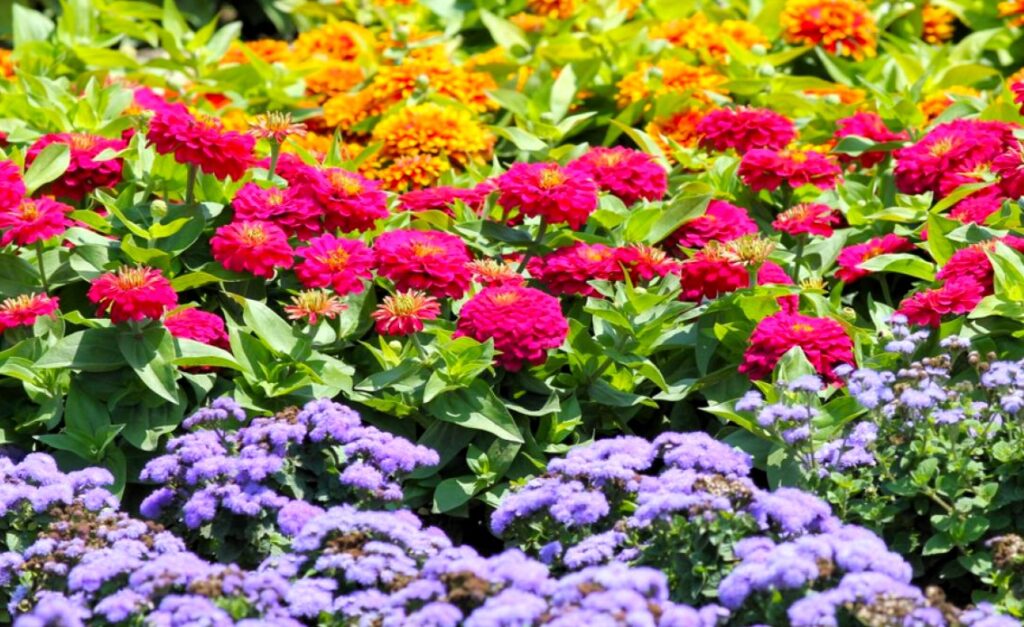
Importance of Flower Gardening
Flower gardening is more than just a hobby; it’s a means of connecting with nature, creating beautiful landscapes, and supporting pollinators. Flowers provide visual interest, attract beneficial insects, and contribute to the overall health and biodiversity of ecosystems. Engaging in flower gardening can also promote mental well-being and relaxation, offering a therapeutic escape from the stresses of daily life.
The Beauty of Flower Gardening
Flower gardening offers a myriad of benefits, both aesthetic and therapeutic. Here are some reasons why you might want to start your own flower garden:
- Aesthetic Appeal: Flowers add beauty, color, and texture to outdoor spaces, creating a visually stunning landscape that delights the senses.
- Fragrance: Many flowers emit delightful scents that perfume the air and uplift the spirit, turning your garden into a fragrant oasis.
- Pollinator Habitat: Flowers attract bees, butterflies, and other pollinators, supporting biodiversity and contributing to a healthy ecosystem.
- Therapeutic Benefits: Gardening has been shown to reduce stress, improve mood, and promote overall well-being. Spending time outdoors surrounded by nature’s beauty can be a calming and rejuvenating experience.
Planning Your Flower Garden
Before you start planting, it’s important to plan your flower garden carefully. Here are some factors to consider:
- Location: Choose a sunny spot for your flower garden, as most flowering plants require at least 6-8 hours of sunlight per day. However, some shade-loving flowers can thrive in partially shaded areas.
- Soil Quality: Test your soil to determine its pH level and nutrient content. Most flowering plants prefer well-drained soil that is rich in organic matter. Amend the soil as needed to create the optimal growing conditions for your flowers.
- Space: Consider the size and layout of your garden, as well as the growth habits of the flowers you intend to plant. Some flowers, like roses and lilies, require plenty of space to spread out, while others, like daisies and marigolds, can be grown closer together.
- Color Scheme: Choose flowers with complementary colors and varying heights to create visual interest and balance in your garden. Consider the overall aesthetic you want to achieve and select flowers that will harmonize with your existing landscape.
- Seasonal Interest: Plan your flower garden to bloom throughout the growing season, from early spring to late fall. Include a mix of spring-blooming, summer-blooming, and fall-blooming flowers to ensure year-round beauty in your garden.
Cultivating a Variety of Flowers
Now that you’ve planned your flower garden, let’s explore how to cultivate a variety of popular flowers. Here are some popular options for the flower garden including their plating guide:
1. Roses
| Scientific Name | Plant Type | Family/Genus | Plant Size | Planting Depth | Planting Zone/Region |
|---|---|---|---|---|---|
| Rosa spp. | Perennial shrub | Rosaceae / Rosa | Varies (from compact shrubs to climbing vines) | 1 inch above the graft union | USDA zones 4-11 |
Description: Roses are versatile and beloved for their exquisite blooms and intoxicating fragrances. From traditional hybrid tea roses to vigorous climbing varieties, there’s a rose to suit every garden style and preference. They require well-drained soil, ample sunlight, and regular care to thrive and produce abundant blooms.

Roses are classic garden favorites known for their beauty, fragrance, and elegance. Here’s how to grow them successfully:
- Varieties: Choose from a wide range of rose varieties, including hybrid teas, floribundas, grandifloras, and climbers. Consider your climate, soil conditions, and desired bloom color and fragrance when selecting roses for your garden.
- Planting: Plant bare-root roses in early spring or container-grown roses in spring or fall. Choose a sunny location with well-drained soil, and dig a hole large enough to accommodate the root ball. Backfill the hole with soil, water thoroughly, and mulch around the base of the plant to retain moisture and suppress weeds.
- Watering: Roses prefer consistent moisture, especially during the growing season. Water them deeply and regularly, especially during hot, dry weather, and avoid overhead watering to prevent disease.
- Fertilizing: Feed roses with a balanced fertilizer formulated for flowering plants, following the manufacturer’s instructions for application rates and timing. Apply fertilizer in early spring, after the first flush of blooms, and again in late summer to promote healthy growth and flowering.
- Pruning: Prune roses in late winter or early spring to remove dead, diseased, or damaged wood and encourage new growth and blooming. Use sharp, clean pruners and make angled cuts just above outward-facing buds.
- Pest and Disease Management: Monitor your roses regularly for signs of pests such as aphids, thrips, and Japanese beetles, as well as diseases like powdery mildew and black spot. Use cultural practices such as proper pruning, good air circulation, and disease-resistant varieties to minimize pest and disease problems.
2. Sunflowers
| Scientific Name | Plant Type | Family/Genus | Plant Size | Planting Depth | Planting Zone/Region |
| Helianthus annuus | Annual | Asteraceae / Helianthus | Varies (from dwarf varieties to towering giants) | 1-2 inches | USDA zones 3-11 |
Description: Sunflowers are iconic for their cheerful blooms and towering stature. They are easy to grow from seed, preferring well-drained soil and full sunlight. With their striking colors and large blooms, sunflowers brighten any sunny spot in the garden or landscape.

Sunflowers are cheerful, sun-loving flowers that add a touch of whimsy to any garden. Here’s how to grow them successfully:
- Varieties: Choose from a variety of sunflower varieties, including dwarf varieties for containers and tall varieties for borders and backgrounds. Consider your garden space and desired bloom size and color when selecting sunflowers.
- Planting: Sow sunflower seeds directly in the garden after the danger of frost has passed, or start them indoors 2-4 weeks before the last frost date. Plant them in well-drained soil enriched with compost, and space them according to the mature size of the variety you’re growing.
- Watering: Sunflowers have deep taproots and are somewhat drought-tolerant once established. Water them deeply and infrequently, allowing the soil to dry out between waterings. Avoid overhead watering to prevent disease.
- Fertilizing: Sunflowers are moderate feeders and benefit from a balanced fertilizer applied at planting time. Side-dress them with additional fertilizer once or twice during the growing season to promote healthy growth and flowering.
- Support: Tall sunflower varieties may require support to prevent them from bending or breaking in strong winds. Stake or cage tall sunflowers to provide support and stability as they grow.
- Harvesting: Harvest sunflower heads when the back of the flower head turns yellow and the seeds are plump and fully developed. Cut the flower heads from the stalk with a few inches of stem attached, and allow them to dry in a warm, well-ventilated area before removing the seeds.
3. Dahlia
| Scientific Name | Plant Type | Family/Genus | Plant Size | Planting Depth | Planting Zone/Region |
| Dahlia spp. | Tuberous perennial | Asteraceae / Dahlia | Varies (from dwarf bedding plants to tall border varieties) | 4-6 inches | USDA zones 8-11 |
Description: Dahlias are prized for their stunning, intricate blooms and wide range of colors and forms. These tuberous perennials require well-drained soil, ample sunlight, and regular fertilization to thrive. With proper care, including regular watering and pruning, dahlias produce abundant blooms from summer to fall.
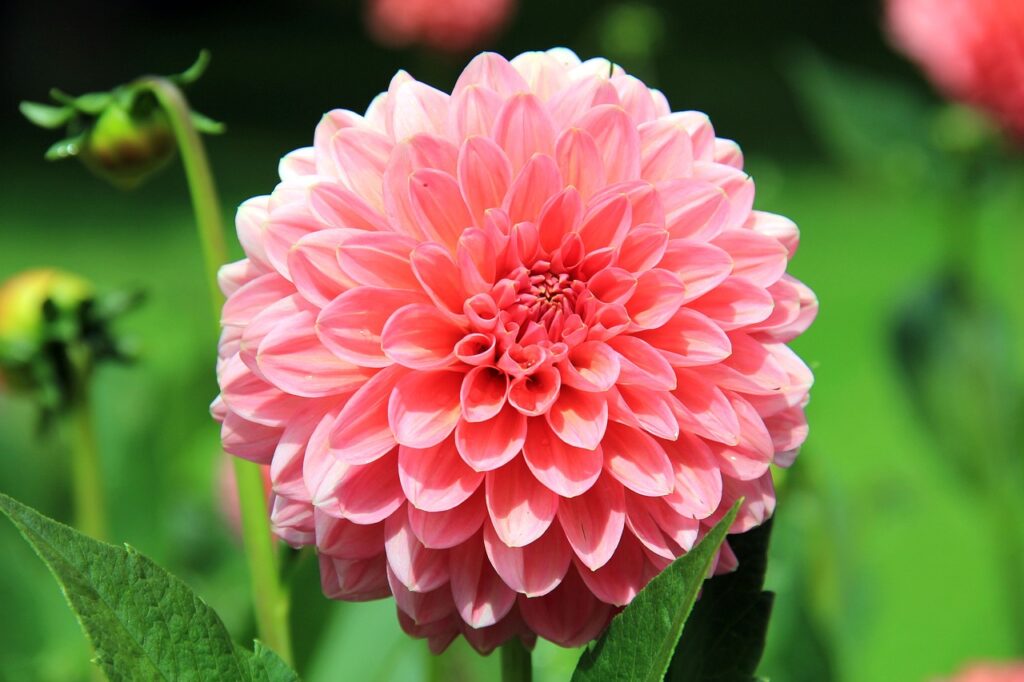
Dahlias are prized for their stunning blooms, which come in a wide range of colors, shapes, and sizes. Here’s how to grow them successfully:
- Varieties: Choose from thousands of dahlia varieties, including ball, pompon, cactus, and dinnerplate dahlias. Consider your garden space, desired bloom size and color, and growing conditions when selecting dahlias for your garden.
- Planting: Plant dahlia tubers in late spring after the danger of frost has passed, or start them indoors 4-6 weeks before the last frost date. Choose a sunny location with well-drained soil, and dig a hole large enough to accommodate the tuber. Plant the tuber horizontally with the eye (growing point) facing upward, and cover it with soil.
- Watering: Dahlias prefer consistent moisture, especially during the growing season. Water them deeply and regularly, especially during hot, dry weather, and mulch around the base of the plants to retain moisture and suppress weeds.
- Fertilizing: Feed dahlias with a balanced fertilizer high in phosphorus to promote healthy root and flower development. Apply fertilizer at planting time and again every 4-6 weeks during the growing season, following the manufacturer’s instructions for application rates.
- Support: Tall dahlia varieties may require staking or support to prevent them from flopping over or breaking in strong winds. Install stakes or cages at planting time to provide support as the plants grow.
- Deadheading: Remove spent flowers regularly to encourage continuous blooming throughout the season. Snip off faded blooms just above a set of healthy leaves to promote new flower bud formation.
- Overwintering: In colder climates, dig up dahlia tubers after the first frost in fall and store them indoors for the winter. Remove excess soil, trim the stems to a few inches, and let the tubers dry for a few days before storing them in a cool, dry place until spring.
4. Marigolds
| Scientific Name | Plant Type | Family/Genus | Plant Size | Planting Depth | Planting Zone/Region |
| Tagetes spp. | Annual or perennial | Asteraceae / Tagetes | Varies (from compact bedding plants to tall border varieties) | 1/4 inch | USDA zones 2-11 |
Description: Marigolds are easy-to-grow annuals or perennials prized for their bright, cheerful blooms and pest-repelling properties. They thrive in full sunlight and well-drained soil, requiring minimal maintenance. Marigolds make excellent companion plants, deterring pests and attracting beneficial insects to the garden.

Marigolds are versatile, easy-to-grow flowers that add a pop of color to any garden. Here’s how to grow them successfully:
- Varieties: Choose from French marigolds, African marigolds, and signet marigolds, as well as different colors and sizes. Consider your garden space, desired bloom size, and color scheme when selecting marigolds.
- Planting: Sow marigold seeds directly in the garden after the danger of frost has passed, or start them indoors 4-6 weeks before the last frost date. Plant them in well-drained soil enriched with compost, and space them according to the mature size of the variety you’re growing.
- Watering: Marigolds are drought-tolerant once established but benefit from regular watering during dry spells. Water them deeply and infrequently, allowing the soil to dry out between waterings. Avoid overhead watering to prevent disease.
- Deadheading: Remove spent flowers regularly to encourage continuous blooming throughout the season. Pinch off faded blooms just above a set of healthy leaves to promote new flower bud formation.
- Pest Control: Marigolds are known for their ability to repel pests such as aphids, nematodes, and whiteflies. Plant them around the perimeter of your garden or among susceptible crops to deter pests naturally.
- Companion Planting: Marigolds make excellent companion plants for vegetables such as tomatoes, peppers, and eggplants. Their strong scent can confuse and repel pests while attracting beneficial insects like ladybugs and hoverflies.
5. Jasmine
| Scientific Name | Plant Type | Family/Genus | Plant Size | Planting Depth | Planting Zone/Region |
| Jasminum spp. | Perennial vine or shrub | Oleaceae / Jasminum | Varies (from compact shrubs to climbing vines) | Same depth as nursery container | USDA zones 6-11 |
Description: Jasmine is prized for its fragrant, star-shaped flowers and glossy green foliage. This perennial vine or shrub thrives in warm climates with well-drained soil and full to partial sunlight. Jasmine blooms profusely in spring and summer, filling the air with its sweet fragrance.

Jasmine is prized for its intoxicating fragrance and delicate white flowers. Here’s how to grow it successfully:
- Varieties: Choose from common jasmine (Jasminum officinale), Arabian jasmine (Jasminum sambac), and winter jasmine (Jasminum nudiflorum), among others. Consider your climate, growing conditions, and desired fragrance when selecting jasmine for your garden.
- Planting: Plant jasmine in a sunny to partially shaded location with well-drained soil. Dig a hole twice as wide and deep as the root ball, and backfill with soil mixed with compost. Water thoroughly after planting, and mulch around the base of the plant to retain moisture and suppress weeds.
- Watering: Jasmine prefers consistent moisture, especially during the growing season. Water newly planted jasmine regularly to help establish a strong root system, then water deeply and less frequently once established.
- Fertilizing: Feed jasmine with a balanced fertilizer formulated for flowering plants in early spring, just before the growing season begins. Apply fertilizer according to the manufacturer’s instructions, and avoid over-fertilizing, as it can lead to excessive foliage growth at the expense of flowering.
- Pruning:Prune jasmine after flowering to remove dead or diseased wood, promote new growth, and maintain a tidy shape. Use sharp, clean pruners to make angled cuts just above outward-facing buds or branches.
- Training: Train climbing jasmine varieties to a trellis, arbor, or fence to encourage vertical growth and maximize bloom display. Tie new growth to the support structure using soft garden twine or plant ties, and prune as needed to maintain the desired shape and size.
6. Tulips
| Scientific Name | Plant Type | Family/Genus | Plant Size | Planting Depth | Planting Zone/Region |
| Tulipa spp. | Bulbous perennial | Liliaceae / Tulipa | Varies (from petite species tulips to tall Darwin hybrids) | 4-6 inches | USDA zones 3-8 |
Description: Tulips are classic spring-blooming bulbs known for their vibrant colors and elegant blooms. They prefer well-drained soil and full to partial sunlight. Tulips come in a wide range of shapes, sizes, and colors, from single-flowered varieties to double-flowered cultivars. Plant tulip bulbs in the fall for a spectacular display of blooms in early spring.
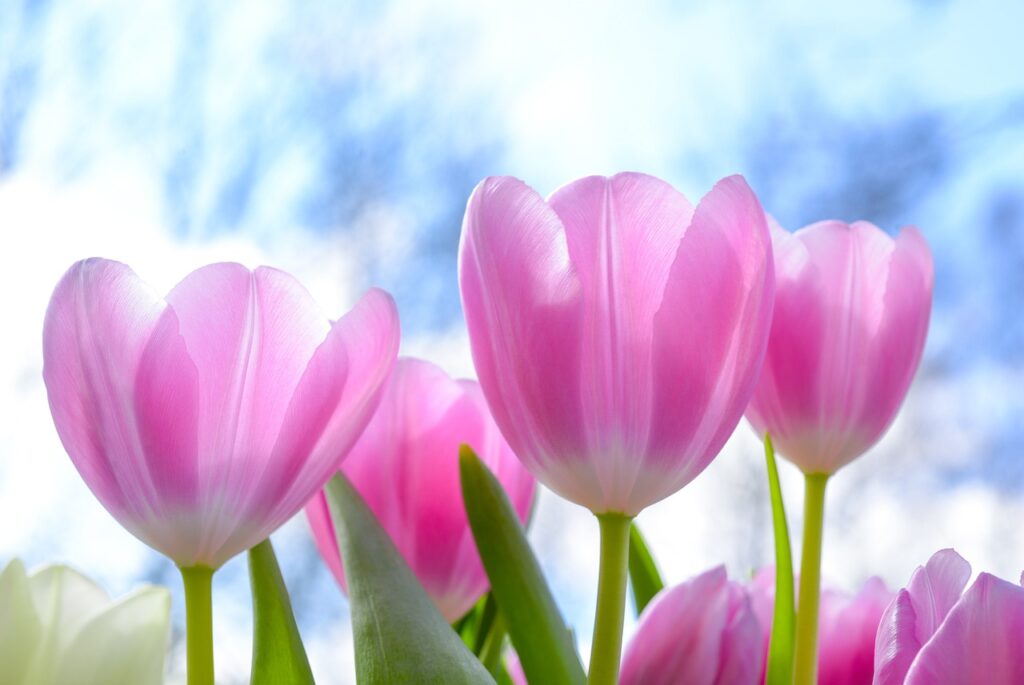
Tulips are beloved spring-blooming bulbs known for their vibrant colors and elegant blooms. Here’s how to grow them successfully:
- Varieties: Choose from a wide range of tulip varieties, including single early, double late, Darwin hybrid, and parrot tulips, as well as different colors and sizes. Consider your climate, growing conditions, and desired bloom time when selecting tulips for your garden.
- Planting: Plant tulip bulbs in the fall, 6-8 weeks before the first frost date, in a sunny to partially shaded location with well-drained soil. Dig a hole 2-3 times as deep as the height of the bulb, and space bulbs according to the mature size of the variety you’re growing.
- Watering: Tulips prefer moist but well-drained soil during their active growth period in spring. Water them regularly, especially during dry spells, but avoid overwatering, as it can lead to rot and disease.
- Fertilizing: Feed tulips with a balanced fertilizer high in phosphorus at planting time to promote healthy root development and flowering. Apply fertilizer according to the manufacturer’s instructions, and avoid fertilizing after the bulbs have finished flowering.
- Deadheading: Remove spent flowers as soon as they fade to prevent the plant from expending energy on seed production. Snip off faded blooms just above the foliage using clean, sharp pruners.
- Naturalizing: Allow tulip foliage to die back naturally after flowering to replenish the bulb for next year’s bloom. Plant tulips in large drifts or clusters for a naturalized look, and avoid disturbing the soil around the bulbs while they’re dormant.
7. Orchids
| Scientific Name | Plant Type | Family/Genus | Plant Size | Planting Depth | Planting Zone/Region |
| Orchidaceae | Epiphytic or terrestrial perennial | Orchidaceae / Various genera | Varies (from miniature orchids to large-flowered varieties) | Varies | Varies |
Description: Orchids are exotic and elegant flowering plants prized for their intricate blooms and diversity. They can be epiphytic (growing on other plants) or terrestrial (growing in soil). Orchids require well-drained, aerated media and specific humidity and temperature conditions to thrive. With proper care, including adequate watering, fertilization, and light, orchids reward growers with long-lasting blooms and striking foliage.
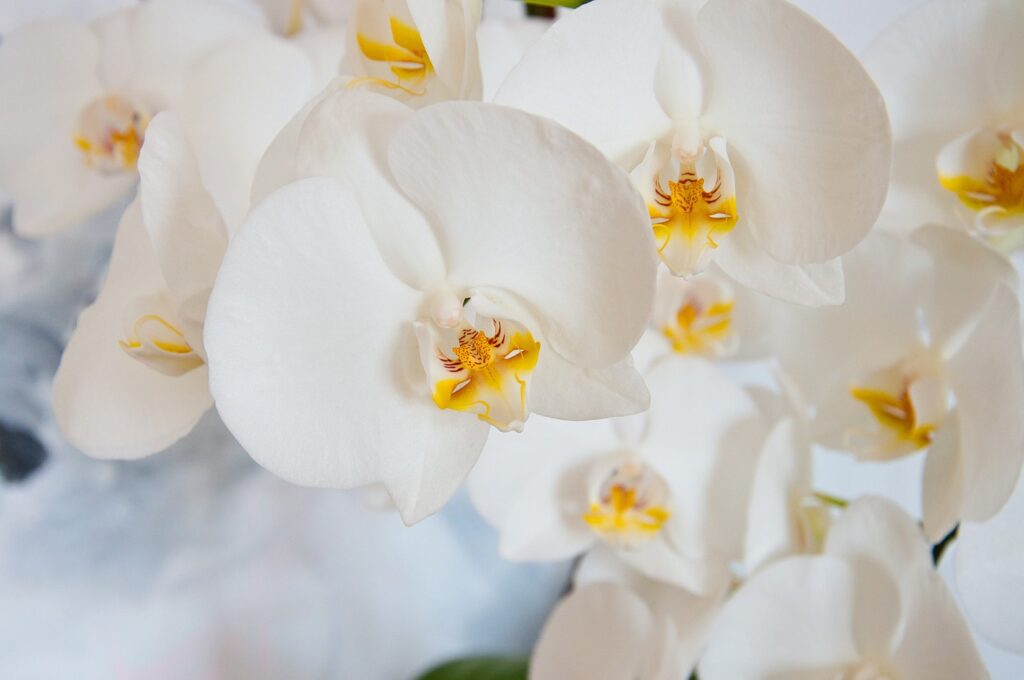
Orchids are exotic and elegant flowers that add a touch of tropical beauty to any indoor space. Here’s how to grow them successfully:
- Varieties: Choose from thousands of orchid species and hybrids, including phalaenopsis, dendrobium, cattleya, and oncidium orchids, as well as different colors, shapes, and sizes. Consider your indoor growing conditions, such as light levels and humidity, when selecting orchids for your home.
- Light: Provide orchids with bright, indirect light, such as an east- or west-facing windowsill. Avoid placing them in direct sunlight, as it can cause sunburn and leaf damage.
- Temperature: Maintain a consistent temperature range of 60-80°F (15-27°C) during the day and 55-65°F (13-18°C) at night for most orchid species. Avoid exposing orchids to drafts or temperature extremes, as it can stress the plants.
- Watering: Water orchids thoroughly when the potting mix is dry to the touch, typically every 7-10 days. Allow excess water to drain freely from the bottom of the pot, and avoid overwatering, as it can lead to root rot and other problems.
- Humidity: Orchids thrive in high humidity environments, with relative humidity levels of 50-70%. Increase humidity around orchids by placing them on a humidity tray filled with water and pebbles, using a room humidifier, or grouping them together with other plants.
- Potting Mix: Use a well-draining orchid potting mix, such as a blend of bark, sphagnum moss, and perlite, to provide adequate aeration and drainage for orchid roots. Repot orchids every 1-2 years to refresh the potting mix and prevent root overcrowding.
- Fertilizing: Feed orchids with a balanced orchid fertilizer diluted to half strength every 2-4 weeks during the growing season. Reduce fertilization frequency during the winter months when orchids are dormant.
- Repotting:Repot orchids when they outgrow their containers or the potting mix breaks down. Choose a slightly larger pot with drainage holes, and gently remove the orchid from its old pot. Trim any dead or rotting roots, and repot the orchid in fresh potting mix.
- Pest and Disease Management: Monitor orchids regularly for signs of pests such as aphids, mealybugs, and scale insects, as well as diseases like root rot and fungal infections. Treat infestations promptly with insecticidal soap or neem oil, and avoid overwatering to prevent disease.
- Blooming: Most orchids bloom once a year, but some species may bloom multiple times a year. Provide orchids with proper care, including adequate light, water, and fertilization, to encourage blooming. Some orchids may require a period of cooler temperatures or reduced watering to initiate flowering.
- Propagation: Propagate orchids through division, stem cuttings, or keiki (baby plant) production. Wait until after flowering to divide orchids or take cuttings, and provide the new plants with appropriate care to ensure successful establishment.
8. Daffodils
| Scientific Name | Plant Type | Family/Genus | Plant Size | Planting Depth | Planting Zone/Region |
| Narcissus spp. | Bulbous perennial | Amaryllidaceae / Narcissus | Varies (from petite miniatures to large-cupped varieties) | 6 inches | USDA zones 3-9 |
Description: Daffodils, also known as narcissus, herald the arrival of spring with their cheerful blooms and vibrant colors. These easy-to-grow bulbs prefer well-drained soil and full to partial sunlight. Daffodils naturalize readily, forming impressive drifts of blooms over time. They are deer-resistant and low-maintenance, making them ideal for beginner gardeners.

Daffodils, also known as narcissus, are cheerful spring-blooming bulbs known for their bright yellow, white, or orange flowers. Here’s how to grow them successfully:
- Varieties: Choose from a variety of daffodil varieties, including trumpet, large-cupped, small-cupped, and double-flowered daffodils. Consider your climate, growing conditions, and desired bloom time when selecting daffodils for your garden.
- Planting: Plant daffodil bulbs in the fall, 4-6 weeks before the first frost date, in a sunny to partially shaded location with well-drained soil. Dig a hole 2-3 times as deep as the height of the bulb, and space bulbs according to the mature size of the variety you’re growing.
- Watering: Daffodils prefer moist but well-drained soil during their active growth period in spring. Water them regularly, especially during dry spells, but avoid overwatering, as it can lead to rot and disease.
- Fertilizing: Feed daffodils with a balanced fertilizer high in phosphorus at planting time to promote healthy root development and flowering. Apply fertilizer according to the manufacturer’s instructions, and avoid fertilizing after the bulbs have finished flowering.
- Deadheading: Remove spent flowers as soon as they fade to prevent the plant from expending energy on seed production. Snip off faded blooms just above the foliage using clean, sharp pruners.
- Naturalizing: Allow daffodil foliage to die back naturally after flowering to replenish the bulb for next year’s bloom. Plant daffodils in large drifts or clusters for a naturalized look, and avoid disturbing the soil around the bulbs while they’re dormant.
9. Daisy
| Scientific Name | Plant Type | Family/Genus | Plant Size | Planting Depth | Planting Zone/Region |
| Bellis perennis | Perennial | Asteraceae / Bellis | Varies (from low-growing ground covers to taller border plants) | Surface sow seeds | USDA zones 4-8 |
Description: Daisies are charming, low-maintenance perennials known for their cheerful blooms and long-lasting flowers. They thrive in full sunlight and well-drained soil, requiring minimal care once established. Daisies attract pollinators and make delightful additions to borders, rock gardens, or containers.
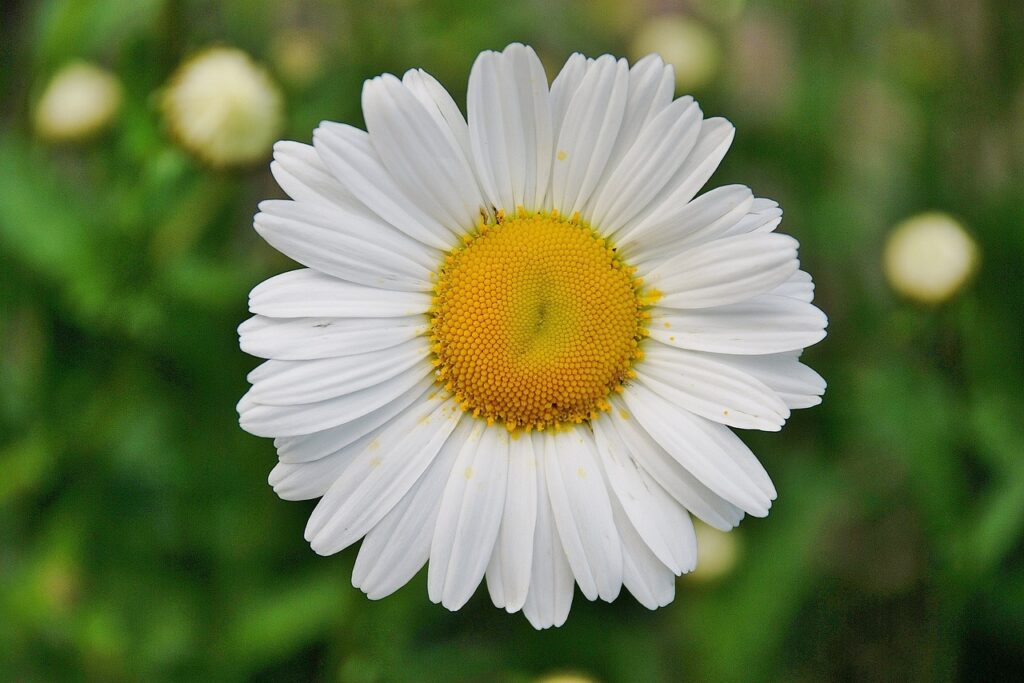
Daisies are charming, easy-to-grow flowers that brighten up any garden with their cheerful blooms. Here’s how to grow them successfully:
- Varieties: Choose from a variety of daisy species, including Shasta daisies, African daisies, and English daisies. Consider your climate, growing conditions, and desired bloom time when selecting daisies for your garden.
- Planting: Plant daisy seeds or transplants in early spring or fall, in a sunny location with well-drained soil. Space plants according to the mature size of the variety you’re growing, and water them thoroughly after planting.
- Watering:Daisies prefer regular watering, especially during dry spells, but they can tolerate some drought once established. Water them deeply and less frequently to encourage deep root growth and drought tolerance.
- Deadheading: Remove spent flowers regularly to encourage continuous blooming throughout the season. Pinch off faded blooms just above a set of healthy leaves to promote new flower bud formation.
- Fertilizing: Feed daisies with a balanced fertilizer high in phosphorus at planting time to promote healthy root development and flowering. Apply fertilizer according to the manufacturer’s instructions, and avoid over-fertilizing, as it can lead to excessive foliage growth at the expense of flowering.
- Dividing: Divide clump-forming daisy varieties every 2-3 years to rejuvenate the plants and prevent overcrowding. Wait until after flowering to divide daisies, and replant the divisions in well-prepared soil.
Lily
| Scientific Name | Plant Type | Family/Genus | Plant Size | Planting Depth | Planting Zone/Region |
| Lilium spp. | Bulbous perennial | Liliaceae / Lilium | Varies (from dwarf Asiatics to towering Orientals) | 6-8 inches | USDA zones 3-9 |
Description: Lilies are elegant and fragrant perennials prized for their graceful blooms and intoxicating fragrance. They prefer well-drained soil and full to partial sunlight. Lilies come in a wide range of colors, shapes, and sizes, from petite Asiatics to majestic Orientals. With proper care, including regular watering and fertilization, lilies provide years of beauty and elegance in the garden.
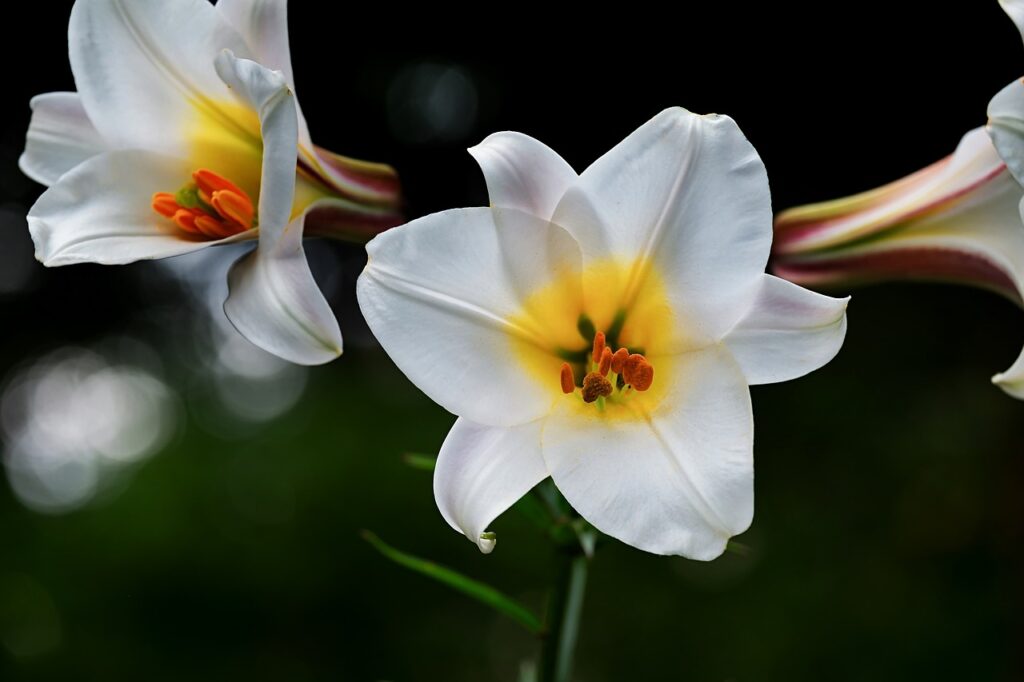
Lilies are elegant and fragrant flowers that add a touch of sophistication to any garden. Here’s how to grow them successfully:
- Varieties: Choose from a variety of lily species, including Asiatic lilies, Oriental lilies, trumpet lilies, and hybrid lilies. Consider your climate, growing conditions, and desired bloom time when selecting lilies for your garden.
- Planting: Plant lily bulbs in the fall, 2-4 weeks before the first frost date, in a sunny to partially shaded location with well-drained soil. Dig a hole 2-3 times as deep as the height of the bulb, and space bulbs according to the mature size of the variety you’re growing.
- Watering: Lilies prefer moist but well-drained soil during their active growth period in spring and summer. Water them regularly, especially during dry spells, but avoid overwatering, as it can lead to rot and disease.
- Fertilizing: Feed lilies with a balanced fertilizer high in phosphorus at planting time to promote healthy root development and flowering. Apply fertilizer according to the manufacturer’s instructions, and avoid fertilizing after the bulbs have finished flowering.
- Support: Tall lily varieties may require staking or support to prevent them from bending or breaking in strong winds. Install stakes or cages at planting time to provide support and stability as the plants grow.
- Mulching: Apply a layer of organic mulch, such as shredded bark or compost, around lily plants to conserve moisture, suppress weeds, and maintain a consistent soil temperature. Avoid mulch contact with the stems to prevent rot and disease.
Conclusion
Flower gardening isn’t just a hobby, it’s a full-on adventure for your senses! Imagine waking up to the sweet smell of roses or watching butterflies flit around your vibrant zinnias. Whether you have a fancy orchid brightening your living room or a whole bed of cheerful sunflowers outside, growing flowers is a fun way to relax, get some sunshine, and even attract some helpful pollinators.
This guide is like your personal flower map, ready to show you exactly how to create a blooming paradise! With a little planning, you’ll pick the perfect flowers for your sunshine and space. Then, just give them some love (water, sunshine, maybe a little talking!), and watch your garden come alive with color and buzzing bees! It takes a little patience, sure, flowers grow at their own pace, but with a sprinkle of creativity, you’ll soon be surrounded by a beautiful explosion of blooms!
So grab your gloves (or just your bare hands!), get ready to get a little dirty, and watch your love for flowers bloom into a gorgeous garden! It’ll bring a smile to your face and brighten everyone’s day.
FAQs
How often should I water my flowers?
The frequency of watering depends on factors such as the type of flower, weather conditions, and soil moisture levels. As a general rule, aim to keep the soil evenly moist, but not waterlogged. Watering deeply and less frequently is usually preferable to shallow, frequent watering.
What should I do if my flowers are not blooming?
Several factors can affect blooming, including insufficient sunlight, poor soil quality, improper watering, or lack of nutrients. Assess the growing conditions and address any issues accordingly. Providing adequate sunlight, well-draining soil, proper watering, and occasional fertilization can help encourage blooming.
How do I prevent pests and diseases in my flower garden?
To prevent pests and diseases, practice good garden hygiene by removing debris and weeds, maintaining proper spacing between plants, and providing adequate air circulation. Monitor plants regularly for signs of pests or diseases, and intervene promptly with appropriate control measures, such as insecticidal soap, neem oil, or organic pesticides.
Can I grow flowers in containers or small spaces?
Yes, many flowers can be grown successfully in containers or small spaces, making them ideal for balconies, patios, or urban gardens. Choose compact or dwarf varieties suited to container growing, use a well-draining potting mix, and provide adequate sunlight and water for optimal growth and blooming.
How do I extend the flowering season in my garden?
To extend the flowering season, choose a variety of flowers that bloom at different times throughout the year, from early spring to late fall. Include early, mid-season, and late-blooming varieties in your garden design, and consider planting annuals, perennials, and bulbs for continuous color and interest.
How can I prolong the blooming period of my flowers?
Deadheading, or removing spent flowers, is one of the most effective ways to prolong the blooming period of many flowers. By removing faded blooms promptly, you encourage the plant to produce new flowers rather than setting seed. Additionally, providing proper care and maintenance, including adequate water, sunlight, and nutrients, can help keep plants healthy and blooming for longer.
What is the best way to fertilize my flowers?
The best way to fertilize flowers depends on the type of flower and its specific nutrient needs. In general, it’s best to use a balanced fertilizer formulated for flowering plants, applied according to package instructions. Avoid over-fertilizing, as excessive nutrients can lead to lush foliage with fewer blooms. Top-dressing with compost or well-rotted manure annually can also help replenish nutrients and improve soil structure.
